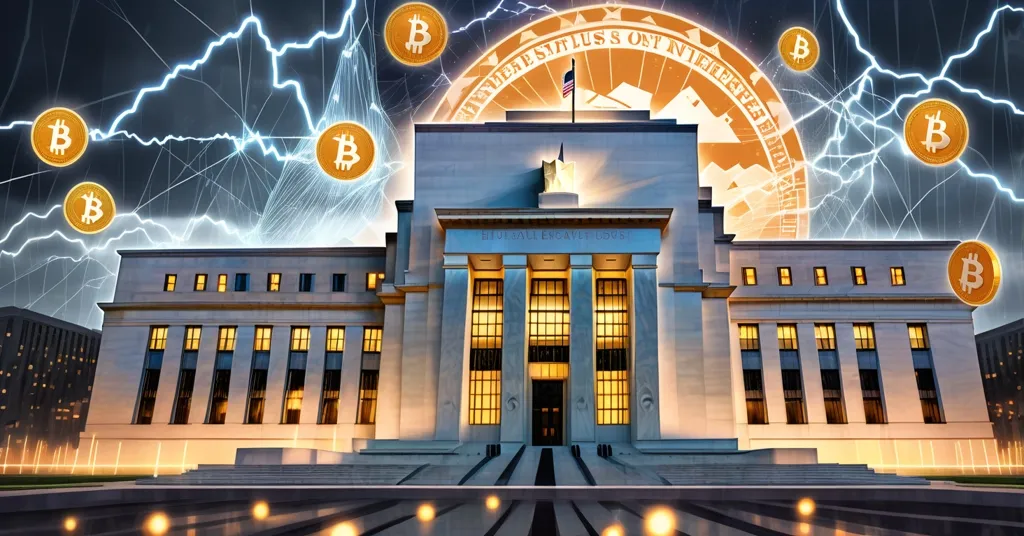Federal Reserve Rate Cut October 2025: How It Could Shake Bitcoin and Crypto Markets

Federal Reserve Decision October 2025: Impact on Bitcoin and Crypto Markets
The financial spotlight is firmly on the Federal Reserve’s upcoming meeting on October 28–29, 2025, where a potential rate cut could ripple through markets, including the wild west of cryptocurrencies. With Bitcoin and Ethereum showing upward momentum, the stakes are high as investors brace for economic data delays and global uncertainties that could either fuel a rally or spark a meltdown.
- Fed’s Next Move: A 25-basis-point rate cut expected, targeting a 3.75-4% range.
- Data Delays: U.S. government shutdown stalls critical jobs figures, muddying Fed’s outlook.
- Crypto Stakes: Rate cuts could drive inflows into Bitcoin and Ethereum, but volatility lurks if policy or data disappoints.
Fed’s Rate Cut: What’s at Stake?
The Federal Reserve is poised to make waves with its anticipated decision to lower the federal funds rate by 25 basis points, aiming for a target range of 3.75-4%. For those just dipping their toes into macroeconomics, the federal funds rate is the baseline interest rate that shapes borrowing costs across the economy, from mortgages to credit cards. A cut signals easier access to money, often nudging investors toward riskier plays like stocks and, crucially for us, cryptocurrencies. Following a prior reduction in September, this move reflects the Fed’s ongoing struggle to balance a softening labor market with inflation that’s still stubbornly above its 2% target.
But the Fed isn’t operating with perfect clarity. A U.S. government shutdown has delayed vital jobs data, like Non-Farm Payrolls and unemployment rates, which are key to assessing the labor market’s health. Analysts warn this lack of insight hampers the Fed’s ability to make fully informed choices, potentially leading to unexpected policy twists. Without these metrics, crucial to the Fed’s dual mandate of price stability and full employment, decision-making becomes a high-stakes guessing game. For crypto markets, already hypersensitive to macro shifts, this uncertainty could mean the difference between a bullish breakout and a brutal correction.
Economic Data Delays: A Hidden Risk
The shutdown’s impact can’t be overstated. Normally, the Fed relies on fresh employment figures to gauge whether the economy needs more stimulus or restraint. Right now, they’re flying half-blind, and that could lead to a more cautious—or even hawkish (favoring higher rates to curb inflation)—stance than markets expect. If the Fed’s tone hints at hesitation, the anticipated liquidity boost might not materialize as hoped, leaving risk assets like Bitcoin in a vulnerable spot.
On a slightly brighter note, inflation seems to be cooling. The Consumer Price Index (CPI), which tracks price changes for everyday goods and services, rose by 0.3% month-on-month and 3.0% year-on-year in September, coming in just below forecasts. This suggests inflation is moderating, potentially giving the Fed room to adopt a dovish (favoring lower rates to boost growth) approach. For crypto investors, a weaker dollar stemming from such a policy could reinforce Bitcoin’s narrative as a hedge against inflation, driving more capital into digital assets. So, is inflation finally playing ball, or are we just catching a breather before the next storm?
Crypto Markets: Bullish Hopes vs. Bearish Realities
While the Fed grapples with these blind spots, crypto markets are already pricing in their version of the future—let’s hope they’ve bet on the right horse. Bitcoin (BTC) and Ethereum (ETH) have been trending upward on platforms like TradingView, with price charts reflecting optimism ahead of the Fed’s decision. Data from CoinMarketCap highlights the sector’s sensitivity to macro events, and history backs this up. During the 2020 easing cycle, for instance, Bitcoin surged over 300% within a year as liquidity flooded markets. Could we see a repeat, or are today’s tighter conditions a dealbreaker?
A Federal Reserve rate cut could significantly impact Bitcoin prices by encouraging investment in digital assets over traditional savings. On-chain metrics from sources like Glassnode also show a spike in Bitcoin accumulation by long-term holders ahead of the meeting, signaling confidence—or perhaps wishful thinking. Ethereum, meanwhile, continues to dominate decentralized finance (DeFi), with platforms like Uniswap handling billions in transactions, proving altcoins carve out critical niches Bitcoin doesn’t touch, from smart contracts to yield farming.
Broader Pressures: Tech Earnings and Global Policies
The Fed’s decision doesn’t exist in isolation. It coincides with major tech earnings from giants like Apple and Nvidia, which often sway risk sentiment across markets. A flop in these reports could trigger a risk-off mood, dragging Bitcoin down with equities despite potential Fed tailwinds. Add to that global policy developments—think European Central Bank or Bank of Japan moves—and you’ve got a perfect storm of volatility for crypto markets to navigate. Economic instability might also push U.S. lawmakers to fast-track crypto clarity—or crackdowns—as digital assets gain mainstream traction. For deeper insights into what investors should be monitoring, check out this analysis on key factors influencing crypto’s next moves.
Let’s play devil’s advocate for a moment. What if persistent inflation, even if cooling, forces the Fed into a surprise pause or hawkish pivot? Markets expecting a cut could be caught off guard, and cryptocurrencies, often hyped as immune to central bank whims, might face a brutal reality check. Bitcoin’s “digital gold” narrative holds strong in easing cycles, but a tightening environment could test even the most diehard HODLers. This isn’t fear-mongering—it’s a reminder that no asset class is invincible, decentralized or not.
Bitcoin Maximalism and the Altcoin Edge
As a Bitcoin maximalist, I’ll always argue that BTC is the ultimate hedge against fiat debasement, especially when central banks loosen the purse strings. Its fixed supply and decentralized nature make it a middle finger to inflationary policies. But I’m not blind to the value altcoins bring. Ethereum’s role in DeFi and smart contracts fills gaps Bitcoin isn’t meant to address, pushing the boundaries of what decentralized systems can achieve. Regardless of the Fed’s moves, Bitcoin and Ethereum keep driving financial innovation—proof that tech doesn’t wait for any central banker, a nod to the spirit of effective accelerationism we champion.
That said, let’s cut through the noise. Those Twitter threads promising BTC at $200K by year-end based on Fed rumors? Pure snake oil. Ignore the hype and focus on the data. Scammers peddling guaranteed returns can shove off—we’re here to inform, not mislead. Crypto’s path forward hinges on real policy outcomes and hard economic indicators, not baseless moonshot predictions.
Key Takeaways for Crypto Investors
- How could the Federal Reserve rate cut in October 2025 affect Bitcoin prices?
A rate cut typically weakens the U.S. dollar and boosts liquidity, often driving investment into risk assets like Bitcoin, though the Fed’s tone and economic stability will heavily shape the outcome. - What does the U.S. government shutdown mean for Fed policy and crypto markets?
The shutdown delays crucial jobs data, limiting the Fed’s insight into labor market health, which could lead to cautious policy moves and heightened uncertainty for crypto price trends. - Why should crypto investors care about inflation data like the CPI?
September’s CPI rise of 0.3% monthly and 3.0% yearly suggests cooling inflation, which could encourage a dovish Fed policy, potentially boosting Bitcoin and Ethereum as alternative stores of value. - What are the main risks for Bitcoin and Ethereum despite a Fed rate cut?
A cautious Fed stance or disappointing economic data could trigger a broader risk asset pullback, leading to sharp corrections in Bitcoin and Ethereum prices. - How do global events and tech earnings add to crypto market volatility?
Overlapping events like tech earnings from major firms and global policy shifts amplify market uncertainty, increasing the likelihood of sudden price swings in cryptocurrencies like Bitcoin and Ethereum.
Practical Insights for Navigating the Chaos
For seasoned investors holding BTC or ETH, consider tightening stop-losses ahead of the Fed announcement—volatility cuts both ways. Newcomers, stick to dollar-cost averaging until the dust settles; jumping in headfirst during uncertain times is a recipe for regret. Whether you’re a Bitcoin purist or an altcoin adventurer, staying informed is your best defense. The Fed’s decision could spark crypto gains if it aligns with expectations, but delayed data and overlapping market pressures are wild cards that could just as easily unleash havoc. This is the beauty and beast of decentralized finance: untethered from traditional systems yet still swayed by their currents. In true decentralized spirit, crypto’s fate isn’t dictated by central banks alone—but damn if they don’t stir the pot.



